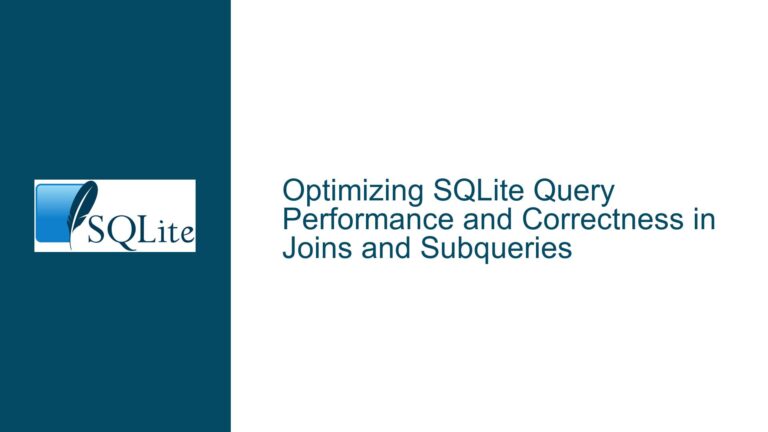SQLite Query Flattener Optimization Critical for Empty IN Clause
Query Flattener’s Role in Processing Empty IN Expressions
The SQLite query optimizer faces a unique challenge when handling empty IN clauses combined with indexed table access patterns. The query flattener optimization, identified by the flag SQLITE_QueryFlattener (0x00000001), plays a crucial role in transforming and simplifying queries containing subqueries with empty IN expressions. When this optimization is enabled, SQLite successfully processes these queries by flattening the nested subquery structure into a more straightforward execution plan. The query flattener specifically handles the transformation of correlated subqueries into joins, which becomes particularly important when dealing with unique indexes and empty set conditions.
The execution path differs significantly between optimized and unoptimized query processing. With the flattener enabled, SQLite can properly evaluate the logical implications of an empty IN clause, treating it as a FALSE condition throughout the query execution. This optimization ensures that the query processor can generate a valid execution plan, even when combining complex conditions like unique indexes with WHERE clauses containing empty IN expressions.
The relationship between unique indexes and empty IN clauses creates an interesting interaction in the query planning phase. When a unique index is created with a WHERE clause containing an empty IN expression, SQLite must carefully manage the index’s selectivity and its application to the query execution plan. The query flattener helps maintain consistency between the index definition and its usage in subsequent queries.
Empty IN Clause Behavior and Index Interaction Complexities
The fundamental complexity arises from the interaction between three key components: the unique index definition, the empty IN clause, and the subquery structure. When creating a unique index with a WHERE clause containing 1 IN (), SQLite establishes a conditional unique constraint that is effectively never satisfied, as an empty IN clause always evaluates to FALSE. This creates a special case in the query optimizer’s decision-making process.
The query planner must handle several intricate scenarios when processing queries with empty IN clauses:
Index Selection Challenges
The presence of the INDEXED BY clause forces SQLite to use a specific index, which complicates the query planning process when combined with empty IN expressions. The query planner must validate whether the chosen index can be effectively utilized given the query’s constraints and the empty set condition.
Subquery Correlation
The correlation between the outer query and the subquery introduces additional complexity. The subquery references the outer query’s table (t0), creating a dependency that the query flattener must resolve. Without the flattener optimization, SQLite struggles to establish a valid execution path that maintains these correlations while respecting the empty IN clause semantics.
Logical Evaluation Order
The order in which SQLite evaluates the various components of the query becomes critical. The empty IN clause in both the index definition and the subquery must be evaluated consistently to maintain logical coherence throughout the execution plan. The query flattener helps establish this consistency by transforming the query structure.
Implementing Robust Query Solutions and Optimization Strategies
To address the query planning challenges and ensure reliable execution, several approaches and solutions can be implemented:
Query Flattener Dependency Management
Applications should maintain awareness of the query flattener optimization’s status and its impact on query execution. When developing queries that involve empty IN clauses and indexed access patterns, the following code pattern ensures proper handling:
PRAGMA query_only = ON;
CREATE TABLE t0 (c0 INT);
CREATE UNIQUE INDEX idx ON t0(c0) WHERE (1 in ());
This configuration helps establish a stable query environment where the optimization status can be consistently managed.
Alternative Query Formulations
When the query flattener cannot be enabled, restructuring the query can provide a viable alternative:
WITH RECURSIVE
empty_set(x) AS (
SELECT NULL WHERE 0
),
transformed_query AS (
SELECT t0.c0
FROM t0
WHERE NOT EXISTS (SELECT 1 FROM empty_set WHERE empty_set.x = t0.c0)
)
SELECT count(*) FROM transformed_query;
This approach eliminates the direct use of empty IN clauses while maintaining equivalent logical semantics.
Index Definition Strategies
When creating indexes that interact with empty IN clauses, consider the following approach to ensure optimal query planning:
-- More robust index definition pattern
CREATE UNIQUE INDEX idx ON t0(c0) WHERE (
c0 NOT IN (SELECT NULL WHERE 0)
);
This pattern provides clearer semantics to the query planner while maintaining the desired logical constraints.
Query Optimization Controls
For applications requiring fine-grained control over query optimization, implementing a configuration management system helps maintain consistent behavior:
-- Optimization control wrapper
BEGIN TRANSACTION;
SAVEPOINT optimization_control;
.testctrl optimizations 0x00000001;
-- Execute query here
ROLLBACK TO optimization_control;
COMMIT;
This transaction-based approach provides isolation for optimization-sensitive operations.
The relationship between query optimizations and execution planning requires careful consideration of several technical aspects:
Memory Management
The query flattener’s transformation process impacts memory usage patterns, particularly when dealing with large result sets or complex query structures. Implementing appropriate memory management strategies becomes crucial for maintaining stable performance.
Transaction Isolation
When executing queries that depend on specific optimization states, maintaining proper transaction isolation ensures consistent behavior across different execution contexts. This becomes particularly important in multi-connection environments where optimization settings might vary.
Index Statistics
The query planner relies heavily on index statistics when determining execution plans. With empty IN clauses and unique indexes, maintaining accurate statistics becomes crucial for optimal plan selection:
ANALYZE t0;
ANALYZE sqlite_master;
Regular statistics updates help the query planner make informed decisions about index usage and query transformation strategies.
Performance Monitoring
Implementing comprehensive performance monitoring helps identify optimization-related issues:
EXPLAIN QUERY PLAN
SELECT count(*) FROM t0 INDEXED BY idx,
(SELECT t0.c0 IN() AS c0 FROM t0) AS v0
WHERE (v0.c0);
This monitoring approach provides visibility into the query planner’s decision-making process and helps identify potential optimization issues before they impact production systems.
The successful execution of queries involving empty IN clauses and indexed access patterns requires a deep understanding of SQLite’s optimization framework and careful attention to query construction patterns. By maintaining awareness of these relationships and implementing appropriate solutions, developers can ensure reliable query execution while maintaining optimal performance characteristics.






